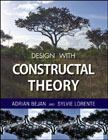
Invented by Adrian Bejan, the constructal theory of global optimization underlocal constraints explains in a simple manner the shapes that arise in nature. The theory is used to understand, calculate, and ultimately generate the irregular designs found in nature (trees, lightning, river deltas, etc.) and incorporate these designs in human-made systems to optimize the function of the system. Now, for the first time in a book, Bejan explains the concepts and applications of his theory, beginning with the basics and building to more and morecomplex systems for better student understanding. INDICE: Preface. List of symbols. 1. Flow Systems. 1.1 Constructal law, vascularization and svelteness. 1.2 Fluid flow. 1.2.1 Internal flow: distributedfriction losses. 1.2.2 Internal flow: local losses. 1.2.3 External flow. 1.3 Heat Transfer. 1.3.1 Conduction. 1.3.2 Convection. References. Problems. 2. Imperfection. 2.1 Evolution to the least imperfect possible. 2.2 Thermodynamics.2.3 Closed systems. 2.4 Open systems. 2.5 Analysis of engineering components.2.6 Heat transfer imperfection. 2.7 Fluid flow imperfection. 2.8 Other imperfections. 2.9 Optimal size of a heat transfer surface. References. Problems. 3.Simple Flow Configurations. 3.1 Flow between two points. 3.1.1 Optimal distribution of imperfection. 3.1.2 Duct cross sections. 3.2 River channel cross sections. 3.3 Internal spacings for natural convection. 3.3.1 Learn by imagining the competing extremes. 3.3.2 Small spacings. 3.3.3 Large Spacings. 3.3.4 Optimal spacings. 3.3.5 Staggered plates and cylinders. 3.4 Internal spacings for forced convection. 3.4.1 Small spacings. 3.4.2 Large spacings. 3.4.3 Optimal spacings. 3.4.4 Staggered plates, cylinders and pin fins. 3.5 The method of intersecting the asymptotes. 3.6 Fitting the solid to the "body" of the flow. 3.7Evolution of technology: from natural to forced convection. References. Problems. 4. Tree Networks for Fluid Flow. 4.1 Optimal proportions: T- and Y- shaped constructs. 4.2 Optimal sizes, not proportions. 4.3 Trees between a point and a circle. 4.3.1 One pairing level. 4.3.2 Free number of pairing levels. 4.4 Performance versus freedom to morph. 4.5 Minimal-lengths trees. 4.5.1 Minimal lengths in a plane. 4.5.2 Minimal lengths in three dimensions. 4.5.3 Minimal lengths on a disc. 4.6 Strategies for faster design. 4.6.1 Miniaturization requires construction. 4.6.2 Optimal trees versus minimal-lengths trees. 4.6.3 75ºAngles. 4.7 Trees between one point and an area. 4.8 Asymmetry. 4.9 Three-dimensional trees. 4.10 Loops, junction losses and fractal-like trees. References. Problems. 5. Configurations for Heat Conduction. 5.1 Trees for cooling a disc-shaped body. 5.1.1 Elemental volume. 5.1.2 Optimally shaped inserts. 5.1.3 One branching level. 5.2 Conduction trees with loops. 5.2.1 One loop size, one branching level. 5.2.2 Radial, one-bifurcation and one-loop designs. 5.2.3 Twoloop sizes, two branching levels. 5.3 Trees at micro and nanoscales. 5.4 Evolution of technology: from forced convection to solid-body conduction. References. Problems. 6. Multiscale Configurations. 6.1 Distribution of heat sources cooled by natural convection. 6.2 Distribution of heat sources cooled by forcedconvection. 6.3 Multiscale plates for forced convection. 6.3.1 Forcing the entire flow volume to work. 6.3.2 Heat transfer. 6.3.3 Fluid friction. 6.3.4 Heat transfer density: the smallest scale. 6.4 Multiscale plates for natural convection. 6.5 Multiscale cylinders in crossflow. 6.6 Multiscale droplets for maximum mass transfer density. References. 7. Multi-Objective Configurations. 7.1Thermal resistance versus pumping power. 7.2 Elemental volume with convection. 7.3 Dendritic heat convection on a disc. 7.3.1 Radial flow pattern. 7.3.2 One level of pairing. 7.3.3 Two levels of pairing. 7.4 Dendritic heat exchangers. 7.4.1 Geometry. 7.4.2 Fluid flow. 7.4.3 Heat transfer. 7.4.4 Radial sheet counterflow. 7.4.5 Tree counterflow on a disc. 7.4.6 Tree counterflow on a square. 7.4.7 Two-objective performance. 7.5 Constructal heat exchanger technology.7.6 Tree-shaped Insulated Designs for the Distribution of Hot Water. 7.6.1 Elemental string of users. 7.6.2 Distribution of pipe radius. 7.6.3 Distributionof insulation. 7.6.4 Users distributed uniformly over an area. 7.6.5 Tree network generated by repetitive pairing. 7.6.6 One-by-one tree growth. 7.6.7 Complex flow structures are robust. References. Problems. 8. Vascularized Materials. 8.1 The future belongs to the vascularized: natural design rediscovered. 8.2 Line-to-line trees. 8.3 Counterflow of line-to-line trees. 8.4 Self-healing materials. 8.5 Grids of channels. 8.6 Multiple scales, loop shapes and body shapes. 8.7 Trees matched canopy to canopy. 8.8 Diagonal channels with multiple sizes. 8.9 Parallel channels for countering intense heating. 8.10 Vascularization will continue to spread. References. Problems. 9. Configurations for Electrokinetic Mass Diffusion. 9.1 Scale analysis of transfer of species through a porous system. 9.2 Model. 9.3 Migration through a finite porous medium. 9.4 Ionic extraction. 9.5 Constructal view of electrokinetic transfer. 9.5.1 Reactive porous media. 9.5.2 Optimization in time . 9.5.3 Optimization in space. References. 10. Mechanical and Flow Structures Combined. 10.1 Optimal flow of stresses. 10.2 Cantilever beam. 10.3 Insulating wall with air cavities and prescribed strength. 10.4 Mechanical structures resistant to thermal attack. 10.4.1 Beam in bending. 10.4.2 Maximization of resistance to sudden heating. 10.4.3 Steel-reinforced concrete. 10.5 Vegetation. 10.5.1 Root shape. 10.5.2 Trunk and canopy shapes. 10.5.3 Conical trunks, branches and canopies. References. Problems. 11. Quo vadis Constructal Theory? 11.1 The constructal law and thermodynamics. 11.2 Two ways to flow are better than one. 11.3 Distributed energy systems. 11.4 Scaling up. 11.5 Survival via greater performance, svelteness and territory. 11.6 Science as a constructal flow architecture. Nomenclature. Appendix. A. The method of scale analysis. B. Lagranges method of undetermined coefficients (Lagrange multipliers). C. Variational calculus. D. Constants. E. Conversion factors. F. Dimensionless groups. G. Nonmetallic solids. H. Metallic solids. I. Porous materials. J. Liquids. K. Gases. References. Figure captions.
- ISBN: 978-0-471-99816-7
- Editorial: John Wiley & Sons
- Encuadernacion: Cartoné
- Páginas: 552
- Fecha Publicación: 19/09/2008
- Nº Volúmenes: 1
- Idioma: Inglés
